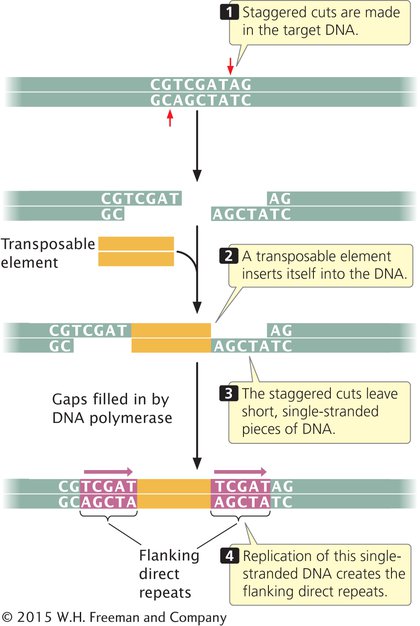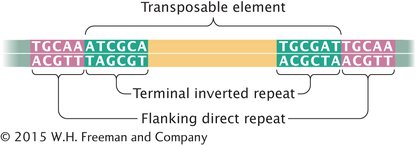General Characteristics of Transposable Elements
There are many different types of transposable elements: some have simple structures, encompassing only those sequences necessary for their own transposition (movement), whereas others have complex structures and encode a number of functions not directly related to transposition. Despite this variation, many transposable elements have certain features in common.
Short flanking direct repeats from 3 to 12 bp long are present on both sides of most transposable elements. The sequences of these repeats vary, but their length is constant for each type of transposable element. These repeats are not a part of the transposable element and do not travel with it. Rather, they are generated in the process of transposition at the point of insertion. The presence of flanking direct repeats indicates that staggered cuts are made in the target DNA when a transposable element inserts itself, as shown in Figure 13.22. The staggered cuts leave short single-

At the ends of many, but not all, transposable elements are terminal inverted repeats, which are sequences from 9 to 40 bp in length that are inverted complements of one another. For example, the following sequences are inverted repeats:
5′—ACAGTTCAG . . . CTGAACTGT—
3′—TGTCAAGTC . . . GACTTGACA—
On the same strand, the two sequences are not simple inversions, as their name might imply; rather, they are inverted complements of one another. (Notice that the sequence from left to right in the top strand is the same as the sequence from right to left in the bottom strand.) Terminal inverted repeats are recognized by enzymes that catalyze transposition and are required for transposition to take place. Figure 13.23 summarizes the general characteristics of transposable elements.  TRY PROBLEM 23
TRY PROBLEM 23

CONCEPTS
Transposable elements are mobile DNA sequences that often cause mutations. There are many different types of transposable elements; most generate short flanking direct repeats at the target sites as they insert. Many transposable elements also possess short terminal inverted repeats.
 CONCEPT CHECK 4
CONCEPT CHECK 4
How are flanking direct repeats created in transposition?
In transposition, staggered cuts are made in DNA and the transposable element inserts into the cut. Later, replication of the single-